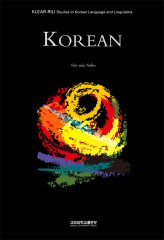Korean
ISBN-13: 978-8976418319
Hardcover: 586 pages
Language: English This volume was originally published by the Routledge in 1994 as one of the Series planned by Bernard Comrie. The Series covers those languages such as Abkhaz, Kobon, Mangarayi, Tamil, West Greenlandic, Japanese, Rumanian, Modern Greek, Amele, Basque, Gulf Arabic, Kannada, Finnish, Catalan, Punjabi, Maori, and Korean, representing diverse language typologies and families. Under the expert leadership of Comrie, a descriptive guideline is prepared and provided for standardized and parallel description of those select languages in the Series.
This particular volume has been sold out immediately after its publication due to highest demand among readers including researchers, instructors, and students of Korean language and linguistics. Its standardized description on grammatical characteristics, concepts and terminologies of Korean language from a perspective of the Korean as one of major world languages serves as a key factor positioning this volume as a must-have reference grammar book for Korean language.
First published in 1994 by Routledge as part of its Descriptive Grammars Series, Korean marked a significant milestone in the internationalization of Korean studies, as it followed the general framework for language description developed by world-renowned typologist, Bernard Comrie. In accordance with the intent of the Routledge series, this allowed the structure of Korean to be presented in a way that facilitates comparison with a broad range of typologically and genetically distinct languages for which parallel reference grammars have been published: Abkhaz, Basque, Tamil, Rumanian, Finnish, Punjabi, and Maori, to name just a few.
Following Comrie’s principles, the book is organized into five major chapters, each covering a different field of inquiry within linguistics: syntax, morphology, phonology, ideophones and interjections, and lexicon. Within each chapter, carefully constructed sections and subsections take the reader through the fine details of the language’s vocabulary and structure, with revealing examples and commentaries underpinning the presentation.
Sohn’s discussion of coordination is a case in point. One of the sixteen major sections in the chapter on syntax, it is subdivided into multiple sub-sections, each dealing with a different aspect of this phenomenon-coordination with ‘and,’ with ‘or’, with ‘but,’ coordination at the level of sentences, coordination at the level of words and phrases, and so on. Reading through these sections, the key points, all amply illustrated, are evident. Not only is the essence of the Korean system easy to discern, the points of differences with other languages, especially English, come quickly to the fore-fulfilling the intent of the book and of the series in which it appears. The entire book is a model of carefully organized and clearly written linguistic exposition and commentary, offering broad coverage of the patterns and phenomena that make Korean unique.
Korean has aged well. It remains a highly accessible and useful compendium of Korean grammar. It is still considered a standard work in the field and is an essential addition to the library of scholars working on Korean linguistics and pedagogy.
— Reviewed by William O’Grady (University of Hawai’i at Manoa)
